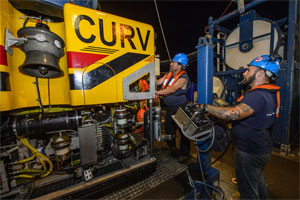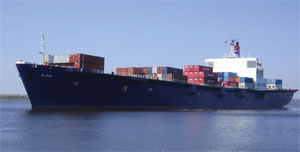The owners of El Faro were told to service both of the ship’s boilers after an onboard inspection in September. This work already had been scheduled for a Nov. 6 dry dock by the time El Faro departed on its final voyage.
All 33 crewmembers died when the 790-foot TOTE Maritime cargo vessel sank Oct. 1 near the Bahamas. Weather forecasts predicted seas of 30 feet with sustained winds of 64 knots, increasing to 105 knots as El Faro approached the eye of the hurricane.
On Oct. 1, the captain called TOTE’s emergency call center and reported that the vessel was experiencing a 15-degree list and had lost its main propulsion unit. Engineers could not get it going again, according to a news release from the National Transportation Safety Board (NTSB), which is in charge of the investigation.
The captain said water had come into hold No. 3 through a scuttle that had blown open, but that the scuttle was secured and the crew was successfully pumping out water from the hold, according to TOTE Maritime. The Coast Guard was unable to speak with the captain.
In 2015, El Faro passed several inspections and surveys. The American Bureau of Shipping (ABS) completed its annual hull and machinery inspections on Feb. 13. The vessel met all rules, and any deficiencies were fixed before the surveys were finished, according to the NTSB. None of the deficiencies were with El Faro’s main propulsion systems. TOTE Services did an annual safety audit of the vessel, which was completed on March 3, according to company records.
El Faro passed its annual Coast Guard inspection, which was conducted on March 5 and 6 in San Juan.
In June an ABS inspector examined and tested the main, auxiliary and emergency systems as part of machinery survey program and found them satisfactory, according to the NTSB.
Then on Sept. 11, TOTE was given permission by the Coast Guard to shut down the ship’s starboard boiler. During a trip from San Juan, Puerto Rico, to Jacksonville, Fla., an independent boiler services company inspected that boiler and recommended that both boilers be serviced at an upcoming dry dock scheduled for Nov. 6, according to the NTSB.
“It was planned maintenance. There were no emergency repairs identified during that (September) inspection,” said Peter Knudson, an NTSB spokesman.
James E. Hall, a safety consultant and former NTSB chairman, said the NTSB would have to investigate the choice to sail toward the storm.
“Here a decision was made, it would appear from the information we have, to sail into a hurricane knowing that two of the essential pieces of machinery on the ship were due for a major overhaul,” Hall said.
The boilers may hold the key to the disaster, said Patrick Morris, who served as a chief engineer and now teaches at California Maritime Academy.
“It was a steam plant. A steam turbine will run forever. They are well built,” he said. “Even if there was something wrong with the gears, you would still have propulsion. A lack of propulsion sounds like you’ve lost the boilers.”
 |
|
During the search for the lost ship, contractors prepare a cable underwater recovery vehicle aboard USNS Apache. |
|
Courtesy U.S. Navy |
In a vessel of this type, “the weak link is the boilers or the combustion or the fuel,” said Morris, who sailed on steamships for 25 years. Electrical problems also could cause a loss of propulsion, according to Hall.
Knudson pointed out that El Faro’s captain did not specify what caused the ship to lose propulsion. “It wasn’t clear if he meant there was a problem with the boiler, or another problem with the propulsion system,” he said.
Whatever the cause, the loss of forward momentum in a hurricane means a ship will lay over on its side in the trough of the waves, said Morris.
At this point the cargo starts to shift, said Ralph Pundt, a former tanker captain and associate professor of marine transportation at Maine Maritime Academy.
In addition to the 294 vehicles and trailers inside El Faro, the ship was carrying 391 containers on its deck.
“She would probably end up going broadside to the waves, which would only enhance the rolling, which only would enhance the cargo shifting,” Pundt said. “It’s just a matter of time before those lashings start to give way.”
TOTE Maritime policies called for some cargo on El Faro to be double-lashed regardless of the weather, according to the NTSB. Stevedores reported that the cargo was secured according to these procedures before the last voyage.
With a loss of propulsion, a hurricane situation can get dangerous rapidly, said Morris. Everyone would be down below trying to get the ship’s propulsion back.
“If I have water in the hold and I have no steering and no propulsion, all of a sudden things get ugly real quickly,” said Morris. “To be in a storm like that is extremely terrifying.”
El Faro was built in 1974 and launched in January 1975 at Sun Shipbuilding and Dry Dock Co. in Chester, Pa. It was lengthened 91 feet and a new midbody was added at Alabama Shipyard Inc. in 1993, according to ABS records. It had an ABS class notation as a vehicle carrier. The vessel had reduced scantlings based on corrosion control and the deck loading was restricted.
In 2011, El Faro was involved in two minor casualties, according to documentation in the U.S. Coast Guard’s Port State Information Exchange. On April 12, the ship reported temporary loss of power when the generator breaker for the main buss tripped offline. Engineers determined the cause was due to the severing of the terminal end of a wire within the exciter. It was successfully repaired.
On Aug. 11, 2011, El Faro was inbound to the marine channel at Sparrows Point outside Baltimore when it lost forward momentum. It was thought the cause was bottom suction, hitting a channel obstruction or shoaling. No evidence of grounding was found during a dive survey.
In December 1984, the vessel touched bottom while maneuvering at Jacksonville and all blades of the propeller were heavily damaged, according to the website 7seavessels.com. The vessel was repaired and returned to service.
Investigators are missing a key tool that would help them determine to what degree the propulsion failure contributed to the October 2015 sinking. The U.S. Navy Salvage and Diving division of Naval Sea Systems Command located the sunken ship Oct. 31 at a depth of about 15,000 feet near Crooked Island, Bahamas. The Navy salvage team, however, could not find the vessel’s voyage data recorder. The debris search operation ended Nov. 15.

